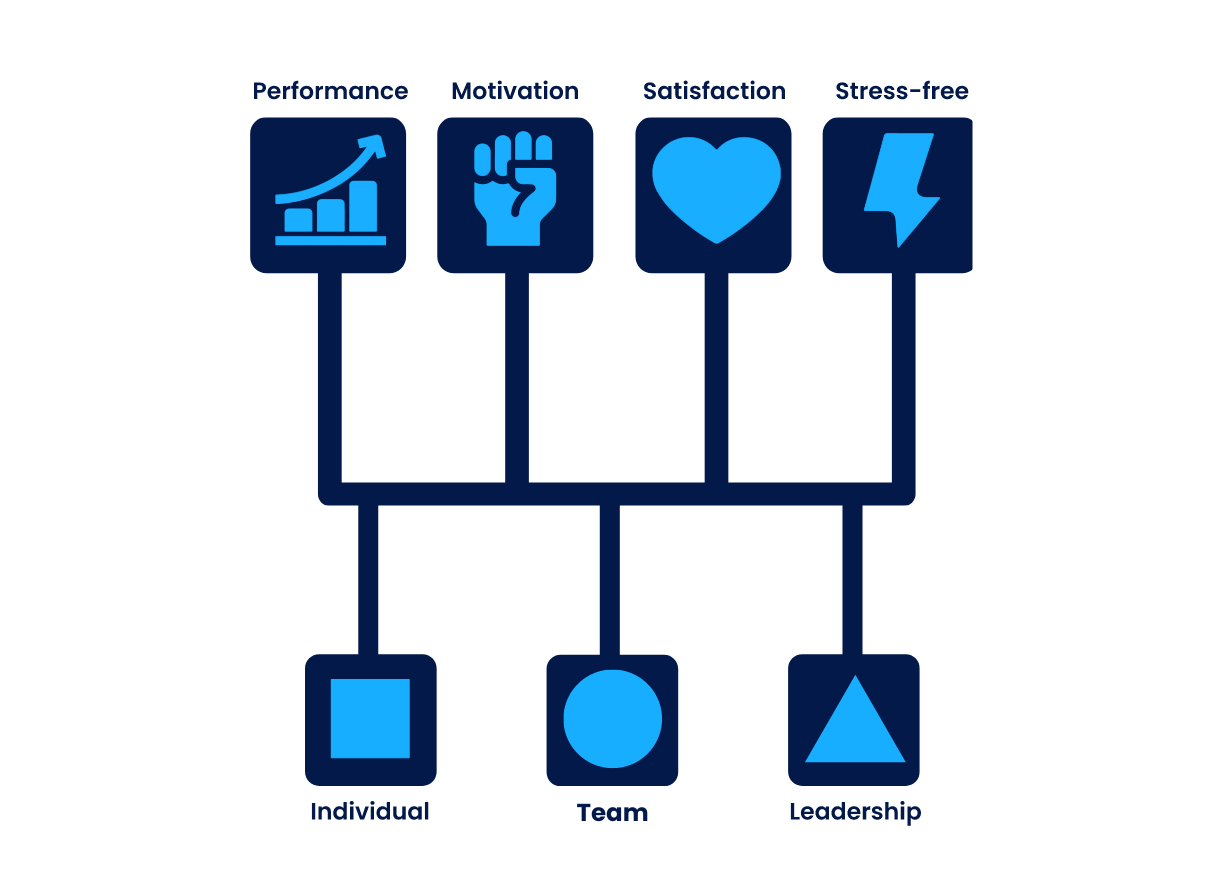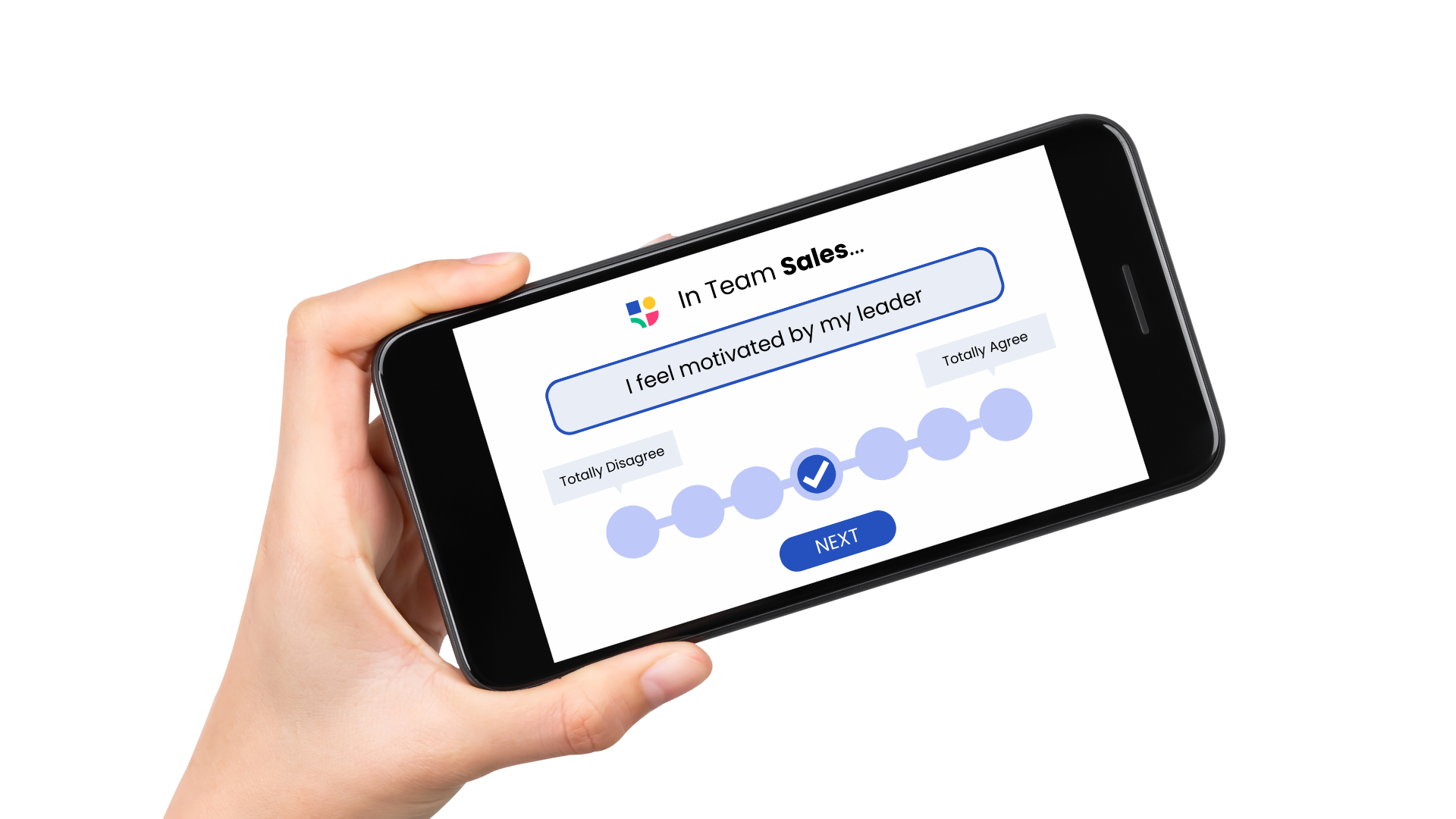This article will answer the following questions:
- Why is it pre-written?
- So, what is a feedback statement exactly?
- How do the statements fit my team environment?
The reality is that as a manager, you don't have the time to formulate thoughtful feedback statements that take into account specific wellbeing and team culture aspects, especially on a weekly or monthly basis. 🤷🏻♀️
How do we know this? We know because it has taken us over three years of dedicated work from experienced professionals to develop an automated feedback loop that can deliver enough statements for at least one monthly feedback collection. Behind this are leadership coaches, industry experts, experienced leaders and more...
We're not just talking about ten quick questions to scratch the surface. Our approach goes much deeper. We strive to touch on all the essential aspects of wellbeing, and this is not something that can be done superficially via a quick measurement.
The process is carefully thought out and allows us to thoroughly analyze all the crucial elements over a longer period of time.
All feedback statements are created to match specific industries and team environments, so we can deliver an automated but qualitative loop. We've created a pool of more than 1000 feedback statements to make it easy, but more importantly, unbiased.
If leaders create feedback statements on their own, they'll only ask within matters based on their perceptions of what is wrong in the team. So many factors might be overlooked.
What you need is an unbiased and objective feedback loop.
In other words, it is not just another "employee survey."
It's much more than that!🔥
So, what is a feedback statement exactly?
The entire foundation of Successteam is built on our feedback statements, as they determine the quality of the feedback and the usefulness of the data for managers.
While we've made it simple for managers to understand their feedback, the underlying process is actually quite complex.
Each feedback loop contains a series of statements. Managers define the frequency of the feedback loop and the number of statements to be answered in each loop.
The statements are unique in each loop to maintain employees' long-term motivation for active participation. At the same time, over time, we ensure that we cover all the essential aspects that impact both wellbeing and performance.
All statements in a loop correlate to one of the primary Indicators and subcategories, as shown below. .png)
So when we gather feedback, we purposely formulate each statement to correlate to a primary indicator and a subcategory which combined creates 12 indicators in total.
Other examples of statements could be:
- "We regularly express gratitude within our team"
- "My leader communicates clearly what is expected of me"
- "I am comfortable giving feedback to my team members"
As you can see above, we ask in the form of a "statement." A team member answers how much they agree from 0 (Totally disagree) to 6 (Totally agree).
.png)
Note that "positively" is not always equal to "Totally Agree" when giving feedback, as some feedback statements are formulated negatively (e.g., "People do not seem to have time to stop and listen").
In this case, if the team answers "Totally Agree," the feedback is calculated as a negative response. This is intentionally done to avoid people responding absentminded, disengaged, and without real thought to the statement.
Each statement has its own normal distribution, but as one statement is insufficient to give a meaningful indication, we collect data from many statements' normal distributions and merge them.
*If fewer than 4 people respond in a team, we can't show any data because it would compromise anonymity.
Team leaders get a dashboard with an overview of the indicators and individual statements, where the results are color-coded. This makes it significantly easier to create a quick overview and understand what to celebrate and what is critical and should be prioritized for action to improve.
 The best part is we'll help leaders prioritize and act on the feedback as well.
The best part is we'll help leaders prioritize and act on the feedback as well.
How the statements fit your team perfectly!👌🏾
A common concern is how well the statements fit a specific team.
- How can we make sure they are applicable?
- What if some don't fit our setting at all?
- How are you certain they are phrased to cover our challenges?
Don't worry! We've got you covered.
They are actually both general and specific at the same time.
This is a paradox, we know, but here's how it works...
Of course, we don't know the ins and outs of every company or team simply because each team is different and consists of unique individuals.
However, larger patterns in employee well-being can be predicted. Things like being heard, appreciated, motivated, challenged, treated fairly, compensated, etc. These factors have been researched and analyzed in-depth; they are broadly identical across industries and environments.
Through our Indicators, we look at the significant patterns on a bigger scale. And this is how we are general.
To get more specific, we ensure we gather vital information about each team in a workspace. For example, we ask about your team industry, size, and work setting (e.g., office, remote, hybrid). The information selected when creating a team dictates the type of statements generated for that particular team's feedback loop.
For example, a statement like "My leader makes an effort to create a team culture, even though we are remote." is very specific to a remote team.
In contrast, "My leader is good at keeping up the pace during rush hours" is created to identify challenges within a team in the service industry.
Below are a couple of examples of different settings generating different statements.
So as displayed above, the statements employees respond to are not just shallow and general. They are very explicitly created based on known challenges in particular environments.
Most importantly, our questions are unbiased and allow the team leaders to check in with their team regularly. Asking questions they might not have thought of asking themselves.
... We are happy you asked!😉
Have you ever had the "It's easier said than done" feeling? The kind of feeling where top management, for example, expressed expectations that are totally unrealistic to live up to? Sometimes they just don't put themselves in your shoes and consider your working conditions, right? Well, we agree!
That's why we worked really hard to put ourselves in your and every other leader's shoes and combined all the knowledge we learned!🔥
One of our primary goals has been to provide a tool that is true to real-life leadership- and team challenges instead of another tool built on theoretical research by non-leaders. Don't get us wrong, academic research is terrific. Still, it can't stand alone because it is simply not applicable to the everyday leader who needs guidance in acting immediately with minimal effort.
We drew knowledge from the following collective sources:
-
Extensive "authentic" Experience
The lived experience creates essential wisdom, so when we say "authentic," it is because the essential factor here is that it is real-life experience with leadership. Not knowledge attained from books, the internet, or through others. We attained our knowledge through numerous leaders' experiences with many types of teams and environments. -
Established Research & Best Practice
Don't worry! We are not against academic or scientific research, although the above could make it seem like it. It is quite the contrary. We dive into the latest peer-reviewed articles, essays, and research to ensure we don't stop evolving our content.We, for example, draw knowledge from people like Daniel Goleman (author of the bestseller Emotional Intelligence), Brené Brown (Author of the bestseller Dare to Lead), or from market leaders such as McKinsey, Google, Microsoft, and many more.
-
Feedback
Feedback, feedback, feedback! Of course, we practice what we preach and thereby improve and act based on our customer's desires. This is both by monitoring how our users behave and their direct feedback through support cases and intended feedback sessions. You never stop learning and improving, and neither do we!
In other words, we have spent endless hours and years gathering and understanding knowledge within leadership and team development. So that we could compile it in a way that is easy for all leaders to understand and actively use with minimal effort.
What if you don't have content for my type of team?
We can cover all white-collar industries (remote, at the office, or hybrid), and we are now growing our content pool for the blue-collar hospitality industries.
We create content for new industries based on demand, so don't hesitate to contact us through info@successteam.com if you want to know if we already provide content for your type of team or if you're going to request a particular kind of content. We might already be working on it.